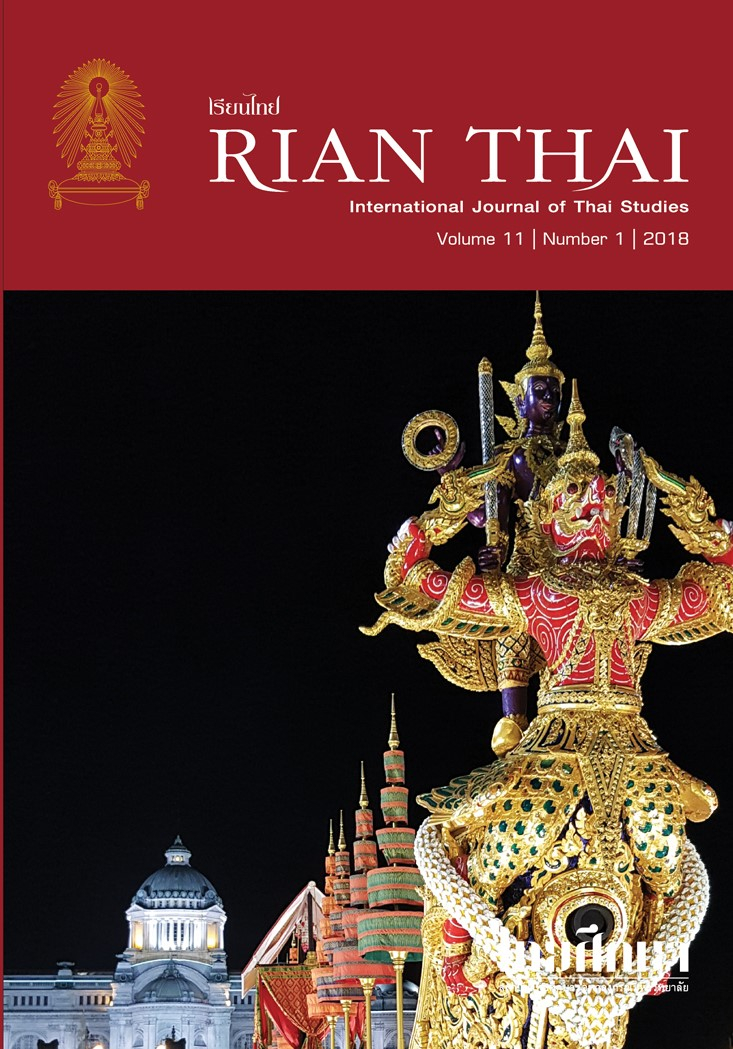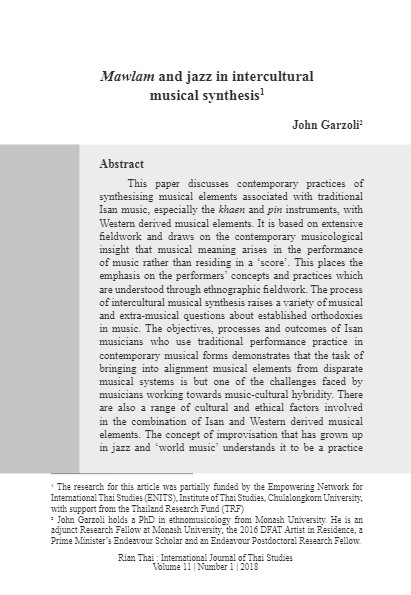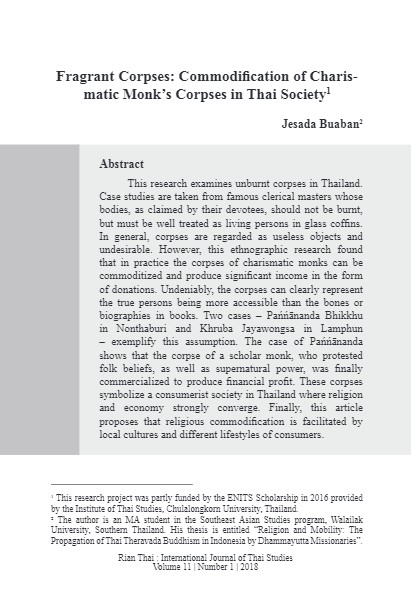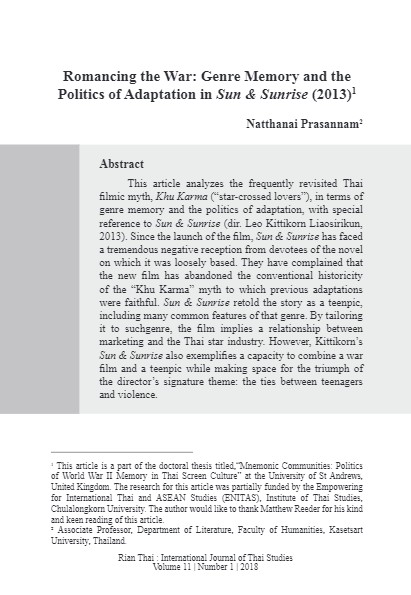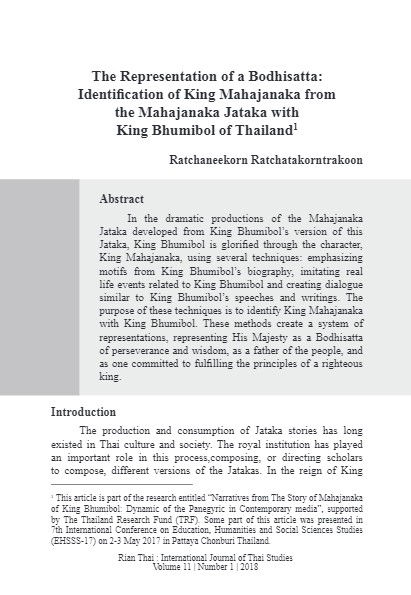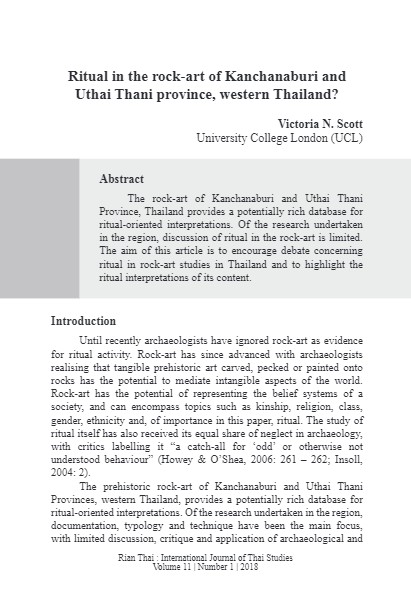Rian Thai - Volume 11/2018 (Number 1)
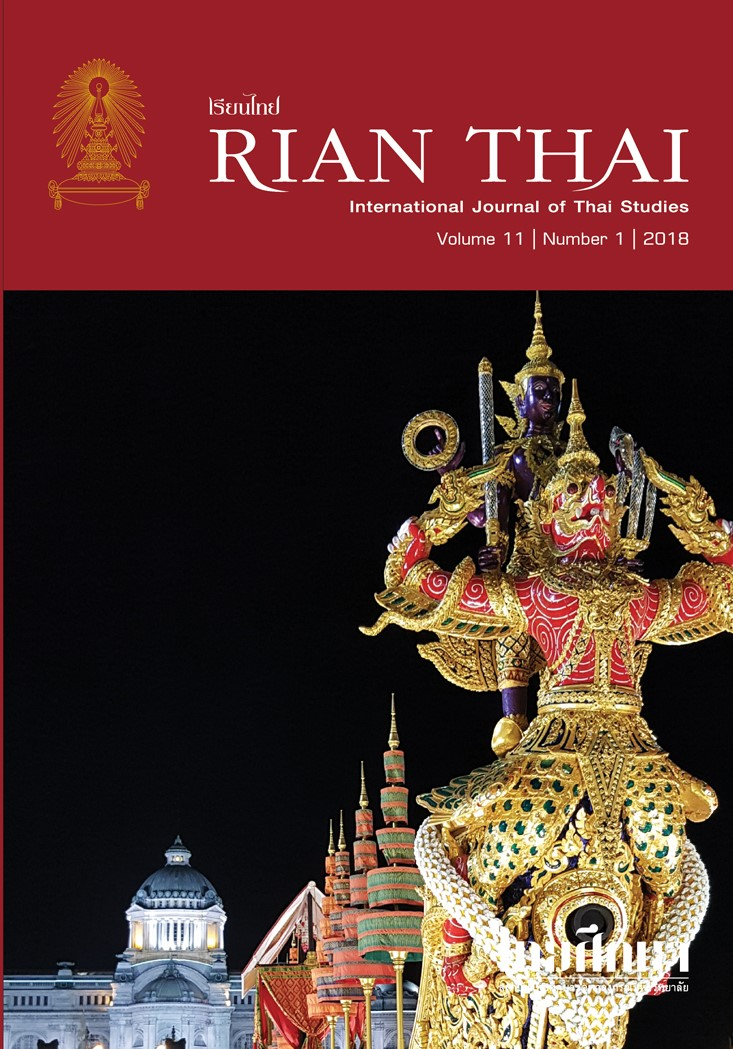
1) Mawlam and Jazz in Interculturalmusical Synthesis / John Garzoli
2) From the Protected Zone to the Unknown: Trajectories of Second Generation Shan Youth in Thai Public Schools and Their Strategies to Overcome Liminal Legality / Janepicha Cheva-Isarakul
3) Fragrant Corpses: Commodification of Charismatic Monk’s Corpses in Thai Society / Jesada Buaban
4) Romancing the War: Genre Memory and the Politics of Adaptation in Sun & Sunrise (2013) / Natthanai Prasannam
5) The Representation of a Bodhisatta: Identification of King Mahajanaka from the Mahajanaka Jataka with King Bhumibol of Thailand / Ratchaneekorn Ratchatakorntrakoon
6) Ritual in the Rock-art of Kanchanaburi and Uthai Thani Province, Western Thailand? / Victoria N. Scott
Mawlam and Jazz in Interculturalmusical Synthesis
John Garzoli
Abstract
This paper discusses contemporary practices of synthesising musical elements associated with traditional Isan music, especially the khaen and pin instruments, with Western derived musical elements. It is based on extensive fieldwork and draws on the contemporary musicological insight that musical meaning arises in the performance of music rather than residing in a ‘score’. This places the emphasis on the performers’ concepts and practices which are understood through ethnographic fieldwork. The process of intercultural musical synthesis raises a variety of musical and extra-musical questions about established orthodoxies in music. The objectives, processes and outcomes of Isan musicians who use traditional performance practice in contemporary musical forms demonstrates that the task of bringing into alignment musical elements from disparate musical systems is but one of the challenges faced by musicians working towards music-cultural hybridity. There are also a range of cultural and ethical factors involved in the combination of Isan and Western derived musical elements. The concept of improvisation that has grown up in jazz and ‘world music’ understands it to be a practice involving personal musical expression. However the idiomatic conventions of traditional khaen and pin playing are more tightly circumscribed and the concept of artistic freedom does not play a significant role in Isan music. Isan musicians who aim to situate their performance within contemporary jazz and ‘world music’ contexts are in a potential conflict between musical and cultural ideals as the value of personal artistic expression enshrined in the ethos of jazz collides with notions of musical and cultural authenticity of Isan music.
(Published in Rian Thai: International Journal of Thai Studies, Volume 11/2018 (Number 1), Page 1-18)
Full Text : Download
From the Protected Zone to the Unknown: Trajectories of Second Generation Shan Youth in Thai Public Schools and Their Strategies to Overcome Liminal Legality
Janepicha Cheva-Isarakul
Abstract
This article explores the everyday experiences of second generation Shan youth at Thai public schools in urban Chiang Mai and their life trajectories after completing middle school (grade 9). Drawing on data from ethnographic fieldwork, it is argued that school is more than a space of differentiation as often portrayed by the literature; it is also space for normalization, protection, inclusion and opportunities. This article also discusses how Shan youths in Chiang Mai put into use the various modes of citizenship they have learned in school to navigate their life outside this “protected zone”.By building an understanding of the day-to-day experiences of inclusions and exclusions of second generation Shan migrants, this article hopes to contribute to broadening discussions on migrant citizenship beyond the legal/illegal dichotomy and generate future dialogue on investigating the mechanisms that produce and sustain illegality.
(Published in Rian Thai: International Journal of Thai Studies, Volume 11/2018 (Number 1), Page 19-30)
Full Text : Download
Fragrant Corpses: Commodification of Charismatic Monk’s Corpses in Thai Society
Jesada Buaban
Abstract
This research examines unburnt corpses in Thailand. Case studies are taken from famous clerical masters whose bodies, as claimed by their devotees, should not be burnt, but must be well treated as living persons in glass coffins. In general, corpses are regarded as useless objects and undesirable. However, this ethnographic research found that in practice the corpses of charismatic monks can be commoditized and produce significant income in the form of donations. Undeniably, the corpses can clearly represent the true persons being more accessible than the bones or biographies in books. Two cases – Pańńānanda Bhikkhu in Nonthaburi and Khruba Jayawongsa in Lamphun – exemplify this assumption. The case of Pańńānanda shows that the corpse of a scholar monk, who protested folk beliefs, as well as supernatural power, was finally commercialized to produce financial profit. These corpses symbolize a consumerist society in Thailand where religion and economy strongly converge. Finally, this article proposes that religious commodification is facilitated by local cultures and different lifestyles of consumers.
(Published in Rian Thai: International Journal of Thai Studies, Volume 11/2018 (Number 1), Page 31-49)
Full Text : Download
Romancing the War: Genre Memory and the Politics of Adaptation in Sun & Sunrise (2013)
Natthanai Prasannam
Abstract
This article analyzes the frequently revisited Thai filmic myth, Khu Karma (“star-crossed lovers”), in terms of genre memory and the politics of adaptation, with special reference to Sun & Sunrise (dir. Leo Kittikorn Liaosirikun, 2013). Since the launch of the film, Sun & Sunrise has faced a tremendous negative reception from devotees of the novel on which it was loosely based. They have complained that the new film has abandoned the conventional historicity of the “Khu Karma” myth to which previous adaptations were faithful. Sun & Sunrise retold the story as a teenpic, including many common features of that genre. By tailoring it to suchgenre, the film implies a relationship between marketing and the Thai star industry. However, Kittikorn’s Sun & Sunrise also exemplifies a capacity to combine a war film and a teenpic while making space for the triumph of the director’s signature theme: the ties between teenagers and violence.
(Published in Rian Thai: International Journal of Thai Studies, Volume 11/2018 (Number 1), Page 51-74)
Full Text : Download
The Representation of a Bodhisatta: Identification of King Mahajanaka from the Mahajanaka Jataka with King Bhumibol of Thailand
Ratchaneekorn Ratchatakorntrakoon
Abstract
In the dramatic productions of the Mahajanaka Jataka developed from King Bhumibol’s version of this Jataka, King Bhumibol is glorified through the character, King Mahajanaka, using several techniques: emphasizing motifs from King Bhumibol’s biography, imitating real life events related to King Bhumibol and creating dialogue similar to King Bhumibol’s speeches and writings. The purpose of these techniques is to identify King Mahajanaka with King Bhumibol. These methods create a system of representations, representing His Majesty as a Bodhisatta of perseverance and wisdom, as a father of the people, and as one committed to fulfilling the principles of a righteous king.
(Published in Rian Thai: International Journal of Thai Studies, Volume 11/2018 (Number 1), Page 75-99)
Full Text : Download
Ritual in the Rock-art of Kanchanaburi and Uthai Thani Province, Western Thailand?
Victoria N. Scott
Abstract
The rock-art of Kanchanaburi and Uthai Thani Province, Thailand provides a potentially rich database for ritual-oriented interpretations. Of the research undertaken in the region, discussion of ritual in the rock-art is limited. The aim of this article is to encourage debate concerning ritual in rock-art studies in Thailand and to highlight the ritual interpretations of its content.
(Published in Rian Thai: International Journal of Thai Studies, Volume 11/2018 (Number 1), Page 101-134)
Full Text : Download
